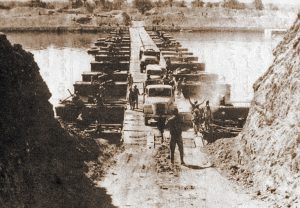The War of Attrition and the Yom Kippur War, 1968-1973

Egyptian forces crossing the Suez Canal
These initially took the form of limited artillery duels and small-scale incursions into Sinai, but by 1969, the Egyptian Army judged itself prepared for larger-scale operations. On March 8, 1969, Nasser proclaimed the official launch of the War of Attrition, characterized by large-scale shelling along the Suez Canal, extensive aerial warfare and commando raids. Hostilities continued until August 1970 and ended with a ceasefire, the frontiers remaining the same as when the war began, with no real commitment to serious peace negotiations.
The Yom Kippur War began on 6 October 1973, when the Arab coalition jointly launched a surprise attack against Israel on the Jewish holy day of Yom Kippur, which had occurred during the 10th day of the Islamic holy month of Ramadan in that year. Following the outbreak of hostilities, both the United States and the Soviet Union initiated massive resupply efforts to their allies (Israel and the Arab states respectively) during the war, which led to a confrontation between the two nuclear-armed superpowers.
Fighting commenced when Egyptian and Syrian forces crossed their corresponding ceasefire lines with Israel and entered the Sinai Peninsula and the Golan Heights. Egyptian forces crossed the Suez Canal in Operation Badr and advanced into the Sinai Peninsula; the Syrians launched a coordinated attack in the Golan Heights to coincide with the Egyptian offensive and initially made gains into Israeli-held territory. After three days of heavy fighting, Israel halted the Egyptian offensive, resulting in a military stalemate on that front, and pushed the Syrians back to the pre-war ceasefire lines. The Israeli military then launched a four-day-long counter-offensive deep into Syria, and within a week Israeli artillery began to shell the outskirts of the Syrian capital of Damascus. Egyptian forces meanwhile pushed for two strategic mountain passes deeper within the Sinai Peninsula but were repulsed, and Israeli forces counter-attacked by crossing the Suez Canal into Egypt and advancing towards Suez City. On 22 October, an initial ceasefire brokered by the United Nations unravelled, with each side blaming the other for the breach.
By 24 October, the Israelis had improved their positions considerably and completed their encirclement of the Egyptian Third Army and Suez City, bringing them within 100 kilometres (62 mi) of the Egyptian capital of Cairo. This development led to dangerously heightened tensions between the United States and the Soviet Union, and a second ceasefire was imposed cooperatively on 25 October 1973, to officially end the war.
Excerpted from War of Attrition, Yom Kippur War, Wikipedia
Overview
Primary Sources
- The Palestinian National Charter- Resolutions of the Palestine National Council July 1-17, 1968.
- Message Addressed by President Sadat to President Leonid Brezhnev, Aug. 30, 1972.
- Memorandum from National Security Council Staff, “Indications of Arab Intentions to Initiate Hostilities,” May 1973.
- Memorandum of Conversation between Muhammad Hafez Ismail and Henry A. Kissinger, May 20, 1973.
- Memorandum from Kissinger to the President, “Meeting with Hafiz Ismail on May 20,” June 2, 1973.
- Henry Kissinger, Memorandum for the President’s Files, “President’s Meeting with General Secretary Leonid Brezhnev on Saturday, June 23, 1973.
- Theodore Eliot, Jr., Executive Secretary State Department, Memorandum for the Record, “Next Steps on the Middle East,” June 29, 1973.
- Memcon between Kissinger and Israeli Ambassador Simcha Dinitz, 10 September 1973.
- Harold Saunders, NSC Staff, to Kissinger, “Memorandum on Your Talk with Zahedi,” 19 September 1973.
- Directive from President Sadat to the Commander-in-Chief of the Armed Forces, Oct. 1, 1973.
- Deputy Assistant to the President for National Security Brent Scowcroft to Kissinger, Enclosing Message from Israeli Prime Minister Golda Meir, 5 October 1973.
- Strategic Directive from President Sadat to the Commander-in-Chief of the Armed Forces, Oct. 5, 1973.
- U.S. Embassy Israel, Cable 7766 to Department of State, “GOI Concern About Possible Syrian and Egyptian Attack Today,” 6 October 1973.
- Message from Secretary Kissinger, New York, to White House Situation Room, for Delivery to President Nixon,October 6, 1973.
- U.S. Mission to United Nations Cable 4208 to U.S. Embassy Israel, October 6, 1973.
- U.S. Department of State Cable 199583 to U.S. Embassies Jordan and Saudi Arabia, “Message from Secretary to King Faisal and King Hussein,” October 6, 1973.
- Memorandum from William B. Quandt to Brent Scowcroft, “Arab-Israeli Tensions,” October 6, 1973.
- Message from Soviet Government to Nixon and Kissinger,October 6, 1973.
- Memorandum from William Quandt and Donald Stukel, NSC Staff, “WSAG Meeting — Middle East, Saturday, October 6, 1973.
- Memorandum to Kissinger, initialed “LSE” (Lawrence S. Eagleburger), October 6, 1973.
- Memcon between Kissinger and Ambassador Huang Zhen, PRC Liaison Office, October 6, 1973.
- Memcon between Dinitz and Kissinger, October 7, 1973.
- Department of State, Operations Center, Middle East Task Force, Situation Report # 8, “Situation in the Middle East, as of 2300 Hours (EDT, Oct. 7, 1973).”
- Kissinger to Egyptian Foreign Minister Al-Zayyat, 8 October 1973, enclosing “Message for Mr. Hafiz Ismail from Dr. Kissinger,” October 8, 1973.
- Memcon 1 between Dinitz and Kissinger, October 9, 1973.
- Memcon 2 between Dinitz and Kissinger, October 9, 1973.
- William Quandt to Kissinger, “Middle Eastern Issues,” October 9, 1973.
- Telegram from President Sadat to President Hafez al-Assad of Syria, Oct. 20, 1973.
- United Nations Security Council Resolution 338, 1973.
- U.S. Interests Section Egypt, Cable 3243 to State Department, “Soviet View on Causes and Timing of Egyptian Decision to Resume Hostilities,” October 26, 1973.
Images
Websites
What do you want to know?
Ask our AI widget and get answers from this website